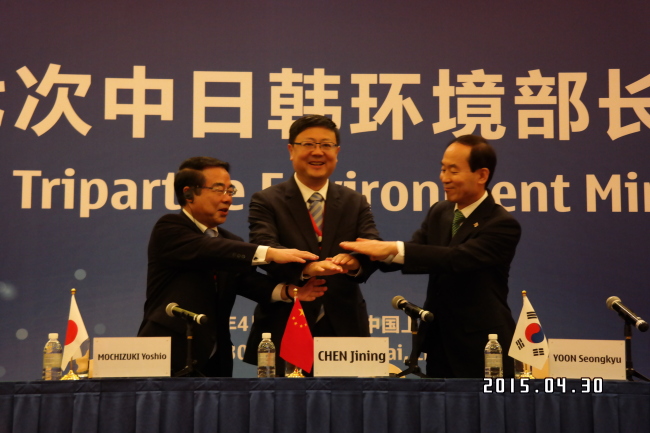SHANGHAI ― Environment ministers from South Korea, China and Japan agreed Thursday to work together to better respond to yellow dust pollution form the Gobi Desert, which poses an increasing health threat in the region.
The agreement drew attention as the Northeast Asian powers were teaming up to deal with environmental challenges, despite their thorny relations over historical and territorial disputes.
They vowed to forecast the yellow dust route together, based on their own yellow dust prediction reports collected through a World Meteorological Organization-affiliated program. This will allow the states to improve their forecast accuracies by comparing each measurement method, officials said.
 |
From right: The environment ministers of South Korea, China and Japan, Yoon Seong-kyu, Chen Jining and Mochizuki Yoshio, join hands after signing the Tripartite Joint Action Plan at the 17th Tripartite Environment Ministers Meeting in Shanghai on Thursday. (Environment Ministry) |
The agreement was part of the five-year environment plan made at the 17th Tripartite Environment Ministers Meeting among Korea, China and Japan or TEMM17 in Shanghai, China, for two days from Wednesday. The annual meeting was held to boost cooperative efforts in tackling various environmental issues, such as yellow dust, fine dust or marine debris.
The three countries’ environment ministers Yoon Sung-kyu of South Korea, Chen Jining of China and Mochizuki Yoshio of Japan joined the event.
The integrated yellow forecast system will be pushed by the joint anti-yellow dust study group, comprised of 30 environment experts. Since 2008, the three countries have run the group to put efforts into improving forecast accuracy while restoring desert areas in China, they added.
Starting with sharing data on yellow dust for the forecast system, the countries will expand the range to fine dust and ultrafine dust soon, officials said.
At the Korea-China bilateral talks on Wednesday, Beijing agreed to provide raw yellow dust data from a number of sites, they said. So far, Korea was able to gain yellow dust data of only four sites from Chinese meteorological agency, not from the environment authorities.
“As most of the yellow dust source sites are in China, the raw data will allow the Korean government to forecast the dust route more precisely,” Yoon said.
In a bid to further prevent the inflow of dust, Seoul’s ministry said it would support Beijing to restore desolated land and conduct a joint study on sustainable land use.
At the Seoul-Tokyo talks, the two countries agreed to share their ultrafine dust information in real time and cooperate more in forecasting yellow dust.
Along with the trilateral agreement on improving air quality, the three countries agreed to create a negotiation channel to seek ways to solve problems with marine debris, officials said.
Japan has urged Korea and China to take action against the growing environmental threat of the sea. Japan has become the country most seriously affected by marine waste from China and Korea, according to an official at Korea’s Environment Ministry.
At the TEMM16 held in Daegu last year, the states determined nine environment agenda to put collective efforts into.
This includes improving air quality; conserving biodiversity; managing chemical materials; sustaining resource cycling; tackling climate change; conserving the maritime environment; raising public awareness; restoring the urban environment; and pushing for a green economy.
By Lee Hyun-jeong (
rene@heraldcorp.com)








![[Today’s K-pop] Blackpink’s Jennie, Lisa invited to Coachella as solo acts](http://res.heraldm.com/phpwas/restmb_idxmake.php?idx=644&simg=/content/image/2024/11/21/20241121050099_0.jpg)